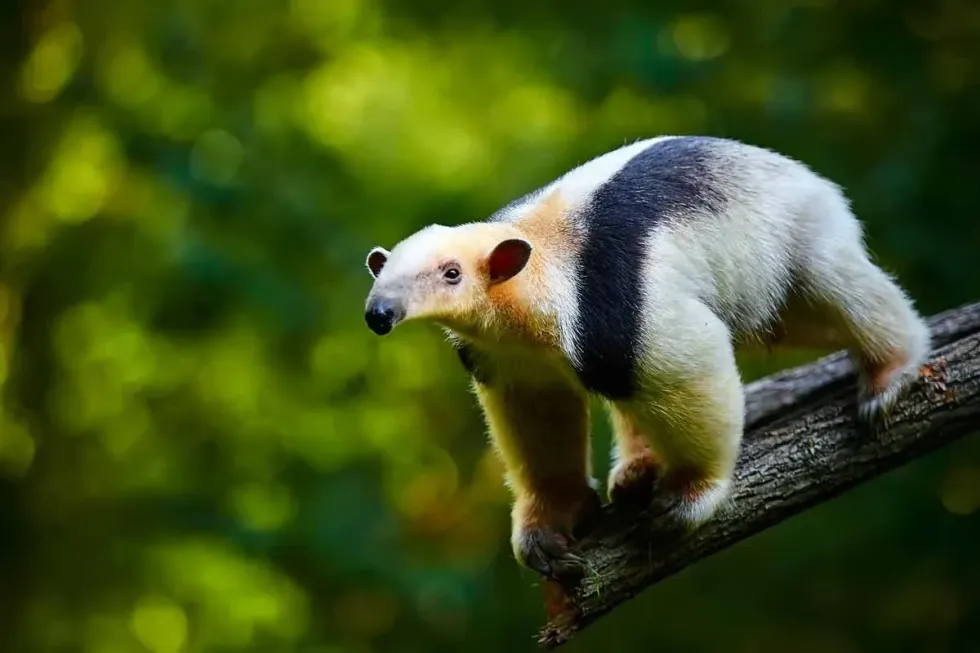The Southern Tamandua, scientifically known as Tamandua tetradactyla, commonly referred to as collared anteater or lesser anteater is a nocturnal (active during the night) species of anteaters. It is a kind of anteater indigenous to the Caribbean island of Trinidad and South America.
The Southern Tamandua is a warm-colored anteater that feeds upon bees, ants, and termites. They reside in damp and dry forests.
They can also be spotted near streams and rivers. They are 21-31.5 in (53.5-80 cm) long and weigh 3-18 lb (1.3-8.1 kg).
It is known as a lesser anteater because of its size, which happens to be less than the size of the giant anteater. The Southern Tamandua anteater is not extinct and falls under the Least Concern category but that doesn't mean this animal has no threats.
It is constantly hunted by hunters for its tail. The tail is very strong and can be used to make rope.
It has four subspecies. The subspecies of Southern tamandua can be spotted in Argentina, Peru, Ecuador, Colombia, Venezuela, Trinidad, areas of Guiana Bolivia, Paraguay, Brazil, and Uruguay.
If you like reading about the amazing Southern Tamandua, then also check out our facts about the giant anteater and striped skunk.
Southern Tamandua Interesting Facts
What type of animal is a Southern Tamandua?
It is a type of anteater indigenous to South America and the Caribbean island of Trinidad of the family Myrmecophagidae. The lesser anteater is a solitary species.
We can spot them in a variety of environments like heavily degraded secondary forests and savannas. They are also commonly known as 'stinker of the forest' because of their smell which is fouler than a skunk.
What class of animal does a Southern Tamandua belong to?
The Southern Tamandua, Tamandua tetradactyla, belongs to the class Mammalia, order Pilosa, family Myrmecophagidae, genus Tamandua, and kingdom Animalia.
How many Southern Tamanduas are there in the world?
The Tamandua tetradactyla, southern tamandua, is widespread but its population is unknown.
Where does a Southern Tamandua live?
This fascinating animal can be found both in trees and on the grass. The tamandua becomes more active at night and also nests in hollow tree trunks during the day.
Tamanduas have tiny eyes and poor vision but they can listen properly and have a great sense of smell.
Southern Tamanduas can be found in most of Central and South America, including Paraguay, Southern Brazil, Suriname, French Guiana, Trinidad and Tobago, and Guyana. Sections of Northern Argentina, Uruguay, Peru, Bolivia, Ecuador, Venezuela, and Colombia are also home to this species.
What is a Southern Tamandua's habitat?
The Southern Tamandua, Tamandua tetradactyla, can be found in a diverse range of habitats, including woods, mangroves, savannas, tropical brush fields, tropical rainforests, and woods, although they are often found alongside streams and rivers. They've been seen at as much as 6,500 ft of height (2,000 m). Tamanduas usually seek refuge in tree hollows when they are not active.
Who do Southern Tamanduas live with?
The Tamanduas are known to be solitary creatures. They choose to live and walk around alone most of the time until it's time for breeding. Mosquitoes and flies are all around them because of their smell. The Tamandua has to wipe them off with their hands as they are so many!
How long does a Southern Tamandua live?
The Southern Tamandua has a life span that ranges between eight to nine years on average.
How do they reproduce?
The lesser anteater breeding season is in the fall season. The female has several estrous cycles which last for an estimated 42 days.
Their gestation period ranges from approximately 130-190 days. In springtime, a baby is born and is solely provided for by the female. The newborn has no resemblance to its mother or father since its coat is a solid color.
The baby lives the first few months of its existence on the female's back. She puts her baby on a healthy branch for a brief period as she searches for food.
What is their conservation status?
As per the IUCN, their conservation status is Least Concern. Usually spotted in wet and dry forests, they are not popular despite their prevalence.
They are killed by hunters who believe the tamanduas are responsible for the deaths of dogs. Their tails are made up of thick tendons making it a good material to make durable rope. Thus they are hunted for this purpose as well.
Southern Tamandua Fun Facts
What do Southern Tamanduas look like?
The Tamandua tetradactyla, southern tamandua, have small but dense fur on their body which acts as self-defense from angry ants. They have big claws similar to those seen on the giant anteater.
The color of their coat depends on where they live. The Southern Tamanduas have black stripes on their shoulders and back and the majority of their body is brown to blond. Their prehensile tail has no fur on the underside, which helps them to grab tree branches more tightly as they walk across the forest.
How cute are they?
The collared anteater looks somewhat cute because of its size and its warm-colored fur. But the odor they emanate sometimes takes away their point for cuteness.
How do they communicate?
Tamanduas communicate through their smell. When they emanate their odor, we know that it's either scared or angry. They only make a sound when they feel threatened, otherwise, they stay silent.
How big is a Southern Tamandua?
Southern tamanduas range in length from 21-31.5 in (53.5-80 cm), with a tail that is capable to grasp, measuring 15-23 in (40-59 mm). They are the same size as that of a monkey.
How fast can a Southern Tamandua move?
They move slowly on the ground and can move from branch to branch easily because of their prehensile tail. They spend 13-64% of their time in tall trees thus their speed is faster when moving through trees rather than on the ground.
How much does a Southern Tamandua weigh?
A southern tamandua weighs about 3-18 lb (1.3-8.1kg). They move very slowly and steadily and this species has one of the lowest body temperatures of any terrestrial mammal, measuring 91 degrees F (33 degrees C). This voracious animal's stomach will accommodate up to 1 lb (0.5 kg) of ants.
What are the male and female names of the species?
There are no particular names for the male and female tamanduas.
What would you call a baby Southern Tamandua?
A baby Southern Tamandua is called a pup.
What do they eat?
Tamanduas primarily consume ants and termites along with honey and bees but they avoid leaf-eating ants and army ants. Army ants have powerful self-defense techniques and thus are avoided. They dig up insect colonies with their limbs and claws and then swallow up their prey with their elongated snout and tongue. Their primary predators are jaguars and domesticated dogs.
Are they dangerous?
Tamanduas normally do not attack humans unless wronged or attacked. Their odor is disgusting and is enough to drive away those irritating them. They can fight with their long and curvy claws. So you must not try to harm the Southern Tamandua. They protect themselves with their powerful forelimbs and paws.
When a predator like a jaguar tries to attack them, the tamandua stands on its legs while balancing itself with the help of its tail, and puts up a powerful defense with its stiff arms and strong claws.
Tamanduas move into a sloping position against a nearby rock or a tree to entrap potential predators with their front legs when on the ground.
When insulted or irritated, Tamanduas hiss and emanate an awful odor through their anal glands. They can even fight with the help of their long claws.
Would they make a good pet?
Keeping a Southern Tamandua pet can be as exhilarating as having a dog. They will keep their owner engaged and the home free from ants and termites. They can be good pets if handled by someone who can cater to their needs efficiently.
Did you know...
Tamanduas, like all anteaters, are members of the Vermilingua suborder, which simply means worm-tongue, referring to their famously lengthy tongues! The tongue of the southern Tamandua is 15.7 in ( 40 cm) long.
Their tails have no hair on the underside, which helps them to grab tree branches more tightly as they walk across the foliage.
Amazonian Indians occasionally use Tamanduas to free their residences from ants and termites.
They are toothless creatures with a strong sense of smell.
Can you own Southern Tamanduas?
They aren't available easily and so the seller can charge a cost ranging from $ 3500-8000. You must be a patient pet owner and be prepared to provide consistent affection and time.
They require a lot of concern and attention. Someone owning a Tamandua must be willing for the ride. The Tamandua will require potty training as well otherwise their foul smell will spread widely in the house and won't go away easily.
They can even suffer from diseases, especially respiratory ones. They also require constant humidity in the air. They must be provided with sufficient space so they can climb around and not feel claustrophobic (fear of small spaces).
Most importantly you should be strong enough to carry it! You will also need to check if you require a permit to own one.
Southern Tamandua vs. Other Anteaters
Since it is much smaller than its counterpart, the giant anteater, the southern tamandua is referred to as a lesser anteater. A southern tamandua is an anteater and can eat one pound of ants.
The northern tamandua has lighter marks on its body or can be of a solid color of brown, black, or blond with no markings. Whereas the Southern tamandua has black stripes on their shoulders and back and the majority of their body is brown to blond.
Here at Kidadl, we have carefully created lots of interesting family-friendly animal facts for everyone to discover! Learn more about some other mammals including caracal or swift fox.
You can even occupy yourself at home by drawing one on our Southern Tamandua coloring pages.










